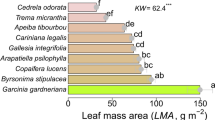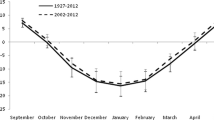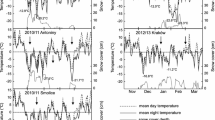Abstract
Two-year-old coastal Douglas-fir (Pseudotsuga menziesii (Mirb.) Franco) seedlings from two seed lots were exposed to controlled freezing temperatures every 4 weeks from October 1993 through April 1994. Freezing effects were assessed by measuring chlorophyll fluorescence emissions 1 day after freezing and by evaluating damage to the bud, cambium, and needle tissues 7 days after freezing. Differences between the seed lots as well as changes in cold hardiness among the bud, cambium, and needle tissues were evident throughout the duration of the study. Tissue damage was higher with increased freezing stress. Severity of damage to each of the tissues varied seasonally. Chlorophyll fluorescence emissions were lower with higher freezing stress (except during November and December, when test temperatures were not low enough to significantly damage the seedlings) and showed a strong relationship with morphological assessments of freezing stress. The slope of the slow kinetics phase of the chlorophyll fluorescence curve tended to be less steep (i.e., quenching was reduced) with higher freezing stress. Nonfrozen chlorophyll fluorescence measurements showed no obvious relationship with LT50 for either seed lot. However, chlorophyll fluorescence measurements are useful for determining cold hardiness and resistance to stress, because they provide a rapid assessment of seedling vigor following exposure to freezing.
Similar content being viewed by others
References
Adams G.T. and Perkins T.D. 1993. Assessing cold tolerance in Picea using chlorophyll fluorescence. Environ. Exp. Bot. 33: 377-382.
Adams W.W. III, Demming-Adams B., Winter K. and Schreiber U. 1990. The ratio of variable to maximum chlorophyll fluorescence from photosystem II, measured in leaves at ambient temperature and at 77K, as an indicator of the photon yield of photosynthesis. Planta. 180: 166-174.
Alden J.N. 1971. Freezing Resistance of Tissues in the Twig of Douglas-Fir Pseudotsuga menziesii (Mirb.) Franco), PhD. thesis, Oregon State University l49p.
Binder W.D. and Fielder P. 1991. A Standardized Environmental Preconditioning Protocol for Making Variable Chlorophyll Fluorescence Measurements. Ministry of Forests, Victoria, BC. FRDA Project 2.19 Extension. 9p.
Binder W.D. and Fielder P. 1996a. Seasonal changes in chlorophyll fluorescence of white spruce seedlings from different latitudes in relation to gas exchange and winter storability. New For. 11: 207-232.
Binder W.D. and Fielder P. 1996b. Chlorophyll fluorescence as an indicator of frost hardiness in white spruce seedlings from different latitudes. New For. 11: 233-253.
Bolhàr-Nordenkampf H.R. and Lechner E.G. 1988. Temperature and light dependent modifications of chlorophyll fluorescence kinetics in spruce needles during winter. Photosynth. Res. 18: 287-298.
Colombo J.C., Zhao S. and Blumwald E. 1995. Frost hardiness gradients in shoots and roots of Picea mariana seedlings. Scand. J. For. Res. 10: 32-36.
Conover W.J. and Iman R.L. 1976. On some alternative procedures using ranks for the analysis of experimental designs. Commua. Stat., Ser. A. 5: 1349-1368.
Devisscher G., Huner N.P.A. and Malek L. 1995. Variable chlorophyll a fluorescence as a potential indicator of black spruce seedling freezing tolerance under nursery conditions. Tree Plant. Notes 46: 107-111.
Dubé S. and Vidaver W. 1990. An integrating fluorometer data acquisition system. Plant. Physiol. Biochem. 28: 1-9.
Fisker S.E., Rose R. and Haase D.L. 1995. Chlorophyll fluorescence as a measure of cold hardiness and freezing stress in 1 + 1 Douglas-fir seedlings: Response to seasonal changes in the nursery. For. Sci. 41: 564-575.
Glerum C. 1985. Frost hardiness of coniferous seedlings: Principles and applications. In: Duryea M.L. (ed.), Evaluating Seedling Quality: Principles, Procedures, and Predictive Abilities of Major Tests. For. Res. Lab., Oregon State Univ., Corvallis, OR, pp. 107-123.
Hawkins C.D.B. and Binder W.D. 1990. State of the art seedling stock quality test based on seedling physiology. In: Rose R., Campbell S.J. and Landis T.D. (eds), Target Seedling Symposium: Proceedings, Combined Meeting of the Western Forest Nursery Associations. For. Serv. Gen. Tech. Rep. RM-200. USDA, pp. 91-121.
Hawkins C.D.B. and Lister G.R. 1985. In vivo chlorophyll fluorescence as a possible indicator of the dormancy stage in Douglas-fir seedlings. Can. J. For. Res. 15: 607-612.
Kautsky H. and Hirsch A. 1931. Neue Versuche zur Kohlensäureassimilation. Naturwissenschaften 19: 964-964.
Krause G.H. and Somersalo S. 1989. Fluorescence as a tool in photosynthesis research: Applications in studies of photoinhibition, cold acclimation, and freezing stress. Phil. Trans. R. Soc. Lond. B. 323: 281-293.
Lindgren K. and Hällgren J. 1993. Cold acclimation of Pinus contorta andPinus sylvestris assessed by chlorophyll fluorescence. Tree Physiol. 13: 97-106.
Martin B., Mårtensson O. and Öquist G. 1978. Seasonal effects on photosynthetic electron transport and fluorescence properties in isolated chloroplasts of Pinus sylvestris. Physiol. Plant. 44: 102-109.
Mohammed G.H., Binder W.D. and Gillies S.L. 1995. Chlorophyll fluorescence: A review of its practical forestry applications and instrumentation. Scan. J. For. Res. 10: 383-410.
Neuner G. and Bannister P. 1995. Frost resistance and susceptibility to ice formation during natural hardening in relation to leaf anatomy in three evergreen tree species from New Zealand. Tree Physiol. 15: 371-377.
Öquist G. and Ögren E. 1985. Effects of winter stress on photosynthetic electron transport and energy distribution between the two photosystems of pine as assayed by chlorophyll fluorescence kinetics. Photosynth. Res. 7: 19-30.
Ritchie G.A. 1984. Assessing seedling quality. In: Duryea M.L. and Landis T.D. (eds), Forest Nursery Manual: Production of Bareroot Seedlings. Martinus Nijhoff / Dr.W. Junk Publishers, The Hague, The Netherlands, pp. 243-259.
SAS Institute, Inc. 1989. SAS/STAT User's Guide Version 6. 4th edn. SAS Institute, Inc., Cary, NC, 846 p.
Strand M. and Lundmark T. 1987. Effects of low night temperature and light on chlorophyll fluorescence of field-grown seedlings of Scots pine (Pinus sylvestrisL. Tree Physiol. 3: 211-224.
Strand M. and Öquist G. 1985a. Inhibition of photosynthesis by freezing temperatures and high light levels in cold-acclimated seedlings of Scots pine (Pinus sylvestris). I. Effects on the light-limited and light-saturated rates of CO2 assimilation. Physiol. Plant. 64: 425-430.
Strand M. and Öquist G. 1985b. Inhibition of photosynthesis by freezing temperatures and high light levels in cold-acclimated seedlings of Scots pine (Pinus sylvestris). II. Effect on chlorophyll fluorescence at room temperature and 77 K. Physiol. Plant. 65: 117-123.
Strand M. and Öquist G. 1988. Effects of frost hardening, dehardening and freezing stress on in vivo chlorophyll fluorescence of seedlings of Scots pine (Pinus sylvestris L.). Plant Cell Environ. 11: 231-238.
Tanaka Y., Brotherton P., Hostetter S., Chapman D., Dyce S., Belanger J. et al. 1997. The operational planting stock quality testing program at Weyerhaeuser. New Forests 13: 423-437.
Timmis R. 1976. Methods of screening tree seedlings for frost hardiness. In: Cannell M.G.R. and Last F.T. (eds), Tree Physiology and Yield Improvement. Academic Press., London, pp. 421-435.
Toivonen P. and Vidaver W. 1984. Integrating fluorometer for the measurement of chlorophyll fluorescence induction in intact plants. Rev. Sci. Instrum. 55: 1687-1690.
Toivonen P. and Vidaver W. 1988.Variable chlorophyll a fluorescence and CO2 uptake in water stressed 2 white spruce seedlings. Plant Physiol. 86: 744-748.
Vidaver W., Binder W., Brooke R., Lister G. and Toivonen P. 1989a. Assessment of photosynthetic activity of nursery grown Picea glauca seedlings using an integrating fluorometer to monitor variable chlorophyll fluorescence. Can. J. For. Res. 19: 1478-1482.
Vidaver W., Binder W., Brooke R., Lister G. and Toivonen P. 1989b. Provenance differences in conifer seedling variable chlorophyll fluorescence responses detected using the integrating fluorometer Proceedings, Intermountain Forest Nursery Association. USDA For. Serv. Gen. Tech. Rep. RM-184., pp. 103-104.
Vidaver W.E., Lister G.R., Brooke R.C. and Binder W.D. 1991. A manual for the use of variable chlorophyll fluorescence in the assessment of ecophysiology of conifer seedlings For. Can. and B.C. Min. For. FRDA Rep. 163.
Weger H.G., Silim S.N. and guy R.D. 1993. Photosynthetic acclimation to low temperature by western red cedar seedlings. Plant. Cell Environ. 16: 711-717.
Westin J., Sundblad L. and Hällgren J. 1995. Seasonal variation in photochemical activity and hardiness in clones of Norway spruce (Picea abies). Tree Physiol. 15: 685-689.
Author information
Authors and Affiliations
Corresponding author
Rights and permissions
About this article
Cite this article
Rose, R., Haase, D. Chlorophyll fluorescence and variations in tissue cold hardiness in response to freezing stress in Douglas-fir seedlings. New Forests 23, 81–96 (2002). https://doi.org/10.1023/A:1015682317974
Issue Date:
DOI: https://doi.org/10.1023/A:1015682317974




